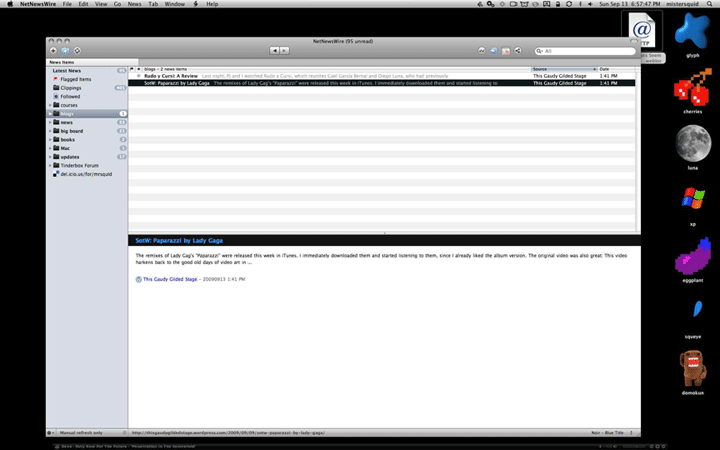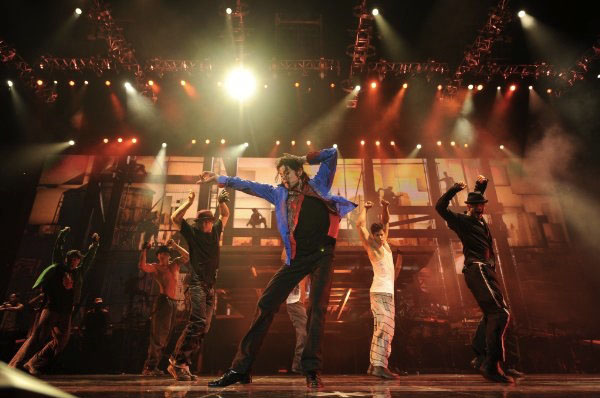In the Future Everyone Will Have Their 12 Seconds of Fame
Prelim
Watching a video debate about whether President Obama should shame unprincipled detractors by identifying them, I came across a video that asks “Is Lady Gaga Sexy Or Just Crazy?” The moment I saw this picture
Lady GaGa in Full Hood

I started googling. Eight minutes later, I purchased Just Dance (featuring Colby O’Donis). Here’s how my 9/11 shopping spree went down:
Buying GaGa
Duration: 17s
Clicking downloads a 2.8MB file.
Please be patient while the file loads
Just Dance was clever and slick enough I added it to my shuffle corpus, but just that. Two days later, Jem made Paparazzi his Song of the Week, and I responded to his commendation by purchasing Paparazzi, regular and remix.1
Two months later, it’s Halloween and I’m three days deep into a flu. Sick, I’m surfing the blue and watching Christopher Walken read the lyrics to Lady GaGa’s Poker Face. Walken’s flat affect, his studied clumsiness and unapologetic regurgitation/recitation of GaGa’s lyrics is, of course, what makes his genius comic.2 Walken sticks so doggedly to the words on the page the impression is that he, like me, had never encountered the lyrics before.
Though synergistic media interconnection moved me to sample Poker Face, The Fame, Beautiful, Dirty Rich, and Boys Boys Boys, I didn’t “Complete My Album” because I was still smarting over The Black Eyed Peas’ The E.N.D. (The Energy Never Dies). 3 Eleven days later, I returned to “Buy Album” and started listening to The Fame on repeat through to today.
When I started writing these notes, I thought I would talk about Lady GaGa’s pop genius, evident in lyrics so self-aware they’re practically sentient, bass so strong it lifts people’s feet, and changeups so sudden they should stumble but they fly. But when reassembling the digital traces of becoming conscious of Lady GaGa, I found an FPP to Jonas Akerlund’s Paparazzi.4 5 I’m ready now to say Lady GaGa’s style is a natural evolution of postmodern aesthetics.
The short film Paparazzi is densely packed, rich with visual style, kinaesthetic meaning, and cultural references. In the clips I briefly discuss below, there are echoes of Cindy Sherman, Brian DePalma, Simon Fields, Alfred Hitchcock, and Fritz Lang. The short uses suture as a self-conscious strategy, reproducing a thematic that descends from Michael Powell’s 1962 Peeping Tom.6
Let’s go see.
Do You Mind If I Switch the Subject?
One of the film’s kinaesthetic signatures is an oscillation between fluid, graceful, slow-motion movements and rapid, jerking, charges. This periodicity not only structures the motion of the film’s subjects, but also the video medium itself. The following clip begins with a closeup of Lady GaGa’s thighs, as she stands knock-kneed, propped up by crutches. The second third of the clip shows the injured GaGa partially collapsing, breaking her fall by bracing herself on her crutches. The frame cuts to GaGa in a different scene, both her hands drawn as mock guns, right one extended. GaGa whips her face toward the camera and pulls her extended arm into the mirror position of the other. Both guns point ceilingward. Her mouth is open in a sneer or a gawk.
|
|
|
The injured Lady GaGa’s partial collapse interrupts GaGa’s steadying shimmy, and the frame cuts away at this vertical “break” in motion, carrying the motion laterally, shifting the focus from a victimized to a villanous GaGa. This quick subjectival shift, whose theme is several times repeated in Paparazzi, is a kinetically maximal update of classic cinematic suture technique. This particular shift has three distinct phases illustrated in the following series of stills.
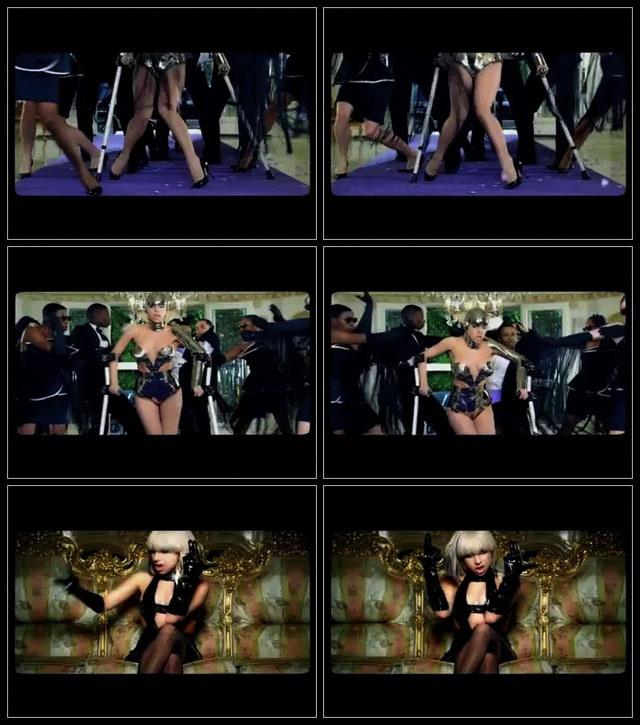
They’re Coming to Get You, GaGa
Before the shift from vicitim to villain, the camera perspective twice zooms GaGa. These twinned zooms cut the sequence into three distinct phases: distant wide, medium full, and close cropped. In the first phase, GaGa is motionless, seated in her wheelchair. Her entourage showcases her immobility by contrast of their punctuated exuberance. The members of GaGa’s entourage move gracefully and confidently. Their vitality draws attention to the frame’s still center, GaGa slumped and disabled. The theme is constructed through the visual dialectic between the vital and the victim.7
Duration: 5s
The sequence reveals GaGa as a species of invalid, her range of motion diminished. To the opposite degree GaGa’s humanity depended on the fullness of her range of motion, GaGa injured can be understood as something beyond human, her transhumanity apparent in a shining skullcap, an artificial arm, and supernumerary legs. GaGa returns from death’s edge as a golden cyborg.
The revelation of GaGa’s transformation and the uncanny beauty of her locomotive style comes in three phases—wide, full, and cropped—the camera’s increasing proximity and the consequent exclusion of GaGa’s extremities from the frame metaphor and analogue for GaGa’s post-traumatic ontology. The camera approaches the paralytic GaGa in jerks and jumps, finishing with a GaGa rebuilt.
The connection between mortality, deathliness, vitality, visuality, and spectatorship unites several disparate entites—GaGa, the camera, her entourage, the audience, the music—within an alternately ruptured and self-repairing cyborg field. This, partially, is the transformation and transduction of an exhausted postmodern aesthetic through cyborg transhumanity.
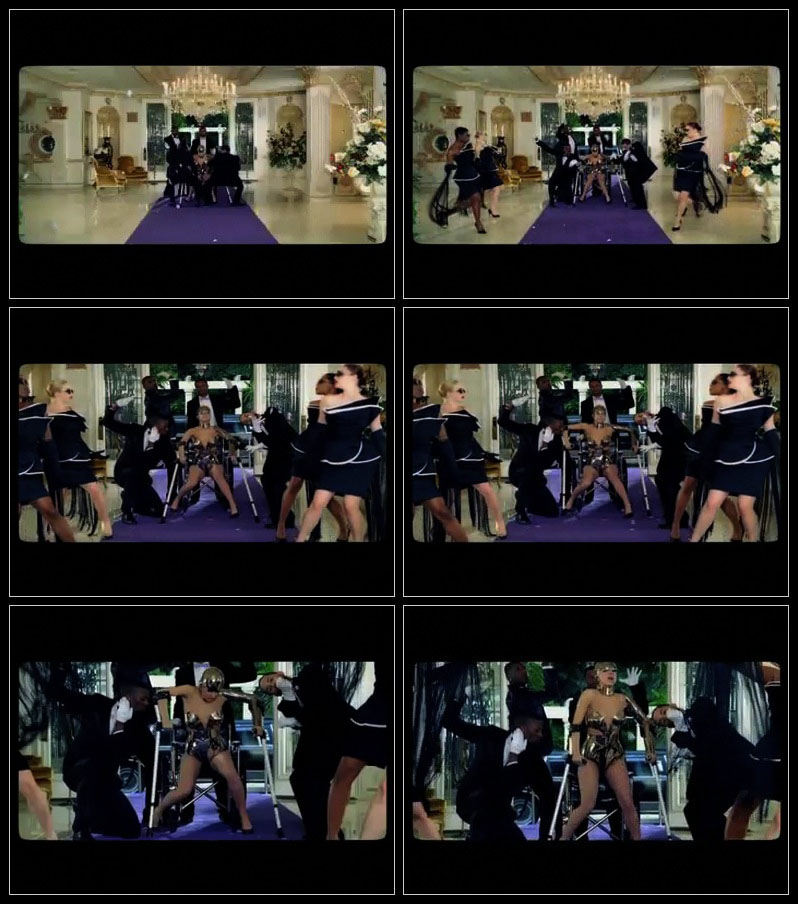
A Tangled Tango
From Michael Myers’ inexorable plodding to Freddie Krueger’s miraculous teleportation to Dracula’s silent flight to the zombie’s shambling stagger to the infected’s frenzied sprint, the monster’s approach reveals something of the nature of the monster’s threat. So does GaGa’s twitching parlalytic stagger reveal something about the threat she poses.
Duration: 6s
GaGa’s shifting figure-eight steps call to mind the Tango’s Ocho with the difference that she does not reverse, but moves unsteadily and implacably toward the camera. Her broken sidewise advance can be read both as teasing and as clumsiness. Like the clips discusssed above, GaGa’s cameraward progress is split into three stages by cutaways to Cindy Shermanesque women who have died, killed themselves, or been murdered.8 In other words, the phases of GaGa’s advances toward the viewer are numerically reflected by the phases of the camera’s approach of GaGa in her wheelchair. Once these phases have passed, GaGa stands before us, our view focused on her legs and crutches.

Combined with the camera’s approach of invalid GaGa, this sequence produces an equation that balances the viewer on one side with GaGa on the other, the camera/screen in the middle producing equivalence between them. The equivalence of GaGa and the viewer through the camera/screen refreshes the predictable postmodern theme that the production of celebrity is on one level the murder of the person who becomes a celebrity. The interchangeability of GaGa and her audience means that the production of celebrity also kills the persons who generate celebrity by the (f)act of viewership.9
GaGa’s spidery cameraward stagger stitches itself together with the bodies of dead women. The connection between victim and viewer establishes in the cuts from Lady GaGa to those bodies. A side-by-side comparison of the two directions of this equation clarifies my meaning.
|
|
|
Postliminary
Given that my brief notes above consider incompletely twelve seconds of film, much more must be said about Paparazzi. A supporting apparatus would draw upon Deleuze and Guattari and my own work concerning race and cybernetics. Given the presence of the dead and GaGa’s rebirth as prostheticized cyborg, the dimension of transduction and the figure of the zombie would be insrumental to this hypotethcial fuller reading.
Important things to consider as I choose between Box Office and Official Platinum.
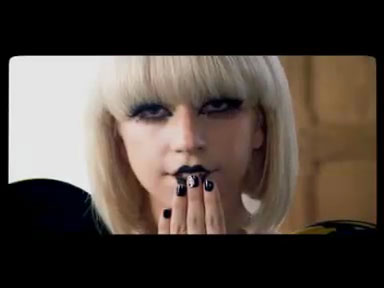
1 To be honest, I didn’t read the entirety of Jem’s post. In fact, I think I only scanned the title and teaser text in NetNewsWire and flagged Jem’s post for safekeeping.
